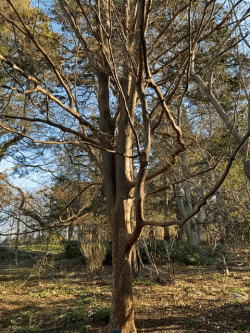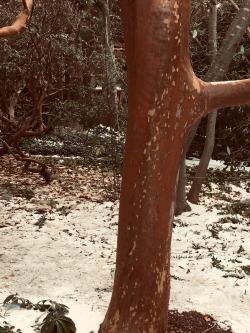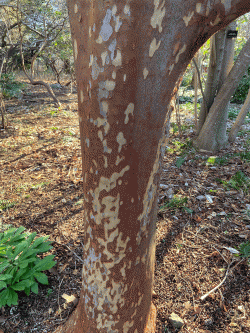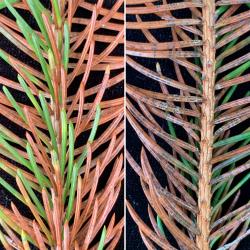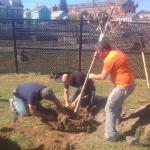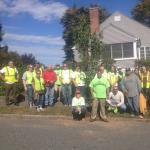A monthly e-newsletter from UMass Extension for landscapers, arborists, and other Green Industry professionals, including monthly tips for home gardeners.
To read individual sections of the message, click on the section headings below to expand the content:
Invasive Insect Webinar Series 2021
January 19 & 26 and February 2 & 9
Join UMass Extension’s Landscape, Nursery, and Urban Forestry Program and UMass Extension’s Fruit Program for this exciting FREE series of webinars focusing on the impact, monitoring, and management of invasive insects in Massachusetts and the nation! Topics to include invasive forest pests in MA, spotted lanternfly, the biological control of winter moth, Asian longhorned beetle updates, planned detection surveys in Massachusetts and New England, integrated pest management of spotted-wing drosophila and brown marmorated stink bug and more! There will also be an update about non-native earthworms, close relatives of the insects, which have attracted a lot of attention in recent years. Please note: while participants from anywhere are invited to attend, much of the material presented will be specific to Massachusetts and New England.
For more details, the full agenda, and to register for these webinars, visit: https://ag.umass.edu/landscape/upcoming-events. Preregistration is required for each day.
For recordings of previous webinars in this series, go to: https://ag.umass.edu/landscape/education-events/invasive-insect-webinars.
This FREE series is supported by the Specialty Crop Block Grant Program at the U.S. Department of Agriculture through grant AM180100XXXXG025. Its contents are solely the responsibility of the presenters and do not necessarily represent the official views of the USDA.
CREDITS
Pesticide Credits
- For each day, 2 pesticide contact hours are available for categories 25, 27, 29, 35, 36, 48 and Applicators (core) license. That is the potential of up to 8 contact hours if attending all the webinars in this series.
- Additionally, 1 pesticide contact hour for category 37 is available on Jan 19 for Invasive Earthworms.
- Pesticide contact hours are available only for the live webinars, not for the recordings.
Association Credits
MCA/MCLPs earn 1 Education Credit for each day for both the live and recorded versions. Submit your request for CEUs using these links:
ISA credits requested.
For more details, the full schedule, and registration info, go to: https://ag.umass.edu/landscape/events/umass-extensions-invasive-insect-webinar-series-2021
2021 UMass Garden Calendar
 It's not too late to get your 2021 UMass Extension Garden Calendar!
It's not too late to get your 2021 UMass Extension Garden Calendar!
For many years, UMass Extension has worked with the citizens of Massachusetts to help them make sound choices about growing, planting and maintaining plants in their landscapes, including vegetables, backyard fruits, and ornamental plants. Our 2021 Garden Calendar continues UMass Extension’s tradition of providing gardeners with useful information. This year’s calendar offers tips on getting started with a vegetable garden with an emphasis on the basics, raised beds, and growing in containers. Many people also love the daily tips and find the daily sunrise/sunset times highly useful!
Show your clients you appreciate their business this year! Bulk pricing is available on orders of 10 copies or more (single copy price: $14/ea).
FOR IMAGES IN THE CALENDAR, details, and ordering info, go to umassgardencalendar.org.
As always, each month features:
- An inspiring garden image.
- Daily gardening tips for Northeast growing conditions.
- Daily sunrise and sunset times.
- Phases of the moon.
- Plenty of room for notes.
- Low gloss paper for easy writing.
Featured Plant
Stewartia monadelpha, Tall Stewartia
Looking to add some interest to your winter garden? Stewartia monadelpha is a slow-growing, small deciduous tree native to Japan with multiple seasons of interest. It is a multi-stemmed tree growing 20-25’ tall and 15-25’ wide with an oval to rounded to open, pyramidal vase shape. Leaves are 1½ - 3 inches long, alternate, simple, elliptic (oval), finely serrated and dark green during summer. In the fall, the leaves turn to a showy red/burgundy fall color. Leaves hold late into the fall but severe cold may reduce the intensity of the fall color. Stewartia is a member of the Camelia family, which is evident in the small, white cup shaped flowers in late June to July. Flowers open over a four week period and do not open as wide as other Stewartia species. The bark is a mosaic of gray, brown and cinnamon flakes with a rich brown under-bark. The cinnamon brown bark is outstanding and helps make Tall Stewartia quite striking in the winter landscape.
Stewartia monadelpha is hardy to USDA zones 6 and is best grown in partial shade, but can handle full sun. It prefers well drained soil and is both drought and heat tolerant. Tall Stewartia can be used singly as a specimen landscape plant or can be used as part of the shrub border. Plants are best located where the flowers and bark can be appreciated, such as near a patio or deck. It has no serious insect or disease problems.
Geoffrey Njue, UMass Extension Sustainable Landscapes Specialist
Questions & Answers
Q. I went a bit overboard last year when purchasing seeds for my vegetable garden and had quite a bit left over that I stuck in a cardboard box in my garage. Can I use them again this upcoming year or should I toss them and start with fresh seeds? How can I tell if the seeds are any good?
A. It’s worth the effort to determine whether or not you can use your leftover seeds, both to save money and to hedge your bets against possible seed supply shortages due to cultivar popularity or the recent tremendous resurgence in home vegetable gardening.
Shelf life
Vegetable seeds can have varying shelf lives. Their longevity is dependent on, among other factors, the kind of vegetable from which they come. For instance, parsnip and onion seeds are short-lived—they are reliable generally just for the year in which you buy them. You’ll want to purchase new seed each year for those crops. Conversely, seeds of vegetables such as kale, pumpkins, and tomatoes may be usable for up to 4 years. A table of expected lifespans of common vegetable seeds is provided below. It is important to remember, however, that seed longevity values are only approximations, since the quality of the seeds as well as how they are handled and stored before and after you’ve received them all play a role in maintaining (or shortening) their shelf life.
| Vegetable | Years | Vegetable | YEars |
|---|---|---|---|
| Bean | 3 | Onion | 1 |
| Beet | 4 | Parsnip | 1 |
| Broccoli | 3 | Pea |
3 |
| Cabbage | 4 | Pepper | 2 |
| Carrot | 4 | Pumpkin | 4 |
| Cauliflower | 4 | Radish | 4-5 |
| Chard | 4 | Spinach | 3 |
| Cucumber | 5 | Squash | 4 |
| Eggplant | 4 | Sweet corn |
2 |
| Kale | 4 | Tomato | 3-4 |
| Leek | 2 | Watermelon | 4 |
| Lettuce | 5-6 | ||
| Table adapated from W.E. Splittstoesser, Vegetable Growing Handbook, 3rd edition (1990) and D. Relf and A. McDaniel, Virginia Cooperative Extension Publication 426-316: Seed for the Garden (2015) | |||
Testing Viability
So perhaps you’ve determined that those leftover seeds are potentially long-lived kinds: snap beans, lettuce, tomatoes, etc. But how viable are they after a winter spent in a cardboard box? Commercial seed companies test their seeds prior to marketing and sell their seeds with an impressive germination rate printed on the seed packet. Like seed longevity, germination rate is an approximation, and actual germination will depend on sowing conditions, seed age, and seed storage. To check for viability of stored seeds, begin with a visual examination. Seeds that appear obviously different from the way they typically look may be candidates for tossing out, e.g., smooth, round seeds that now look wrinkled and shrunken; seeds that crumble or feel soft; seeds with mold and moisture damage. After looking over the seeds, you can get a more accurate picture of viability with a quick test. Spread out a specific sample of seeds (count out anywhere between 10 and 100) from a packet on a dampened paper towel. Fold the paper towel over the seeds and place it in a plastic bag. Put the plastic bag in a warm location, keeping the towel dampened as needed with a spray bottle, and check for seed sprouting regularly over the germination period specified on the seed packet. Divide the number of seeds sprouted by the total number of seeds on the paper towel to get a viability estimate. If fewer than half of the seeds have germinated at the end of this time, it is probably best to purchase new seeds, or plan to sow seeds thickly.
Seed storage for longevity
Proper storage conditions are important if you plan to keep leftover seeds for future use. Keep seeds in the packets they came in for easy identification (and the useful growing information printed on the packet). Fold over packets or seal with tape to keep seeds from falling out and put packets in a container that won’t absorb moisture; a canning jar with screw lid works well. Save those silica gel desiccant sachets that come with mail order purchases, or you can make your own by tying a small amount of powdered milk or uncooked rice grains in a piece of cheesecloth. Drop the desiccant sachet into the jar with the seed packets and screw on the lid. Place the jar in a cool, dark location, preferably with low humidity - a shelf in the refrigerator is ideal.
Jennifer Kujawski, Horticulturist
Trouble Maker of the Month
Needle Blight Pathogens of Spruce
Spruce (Picea spp.) is a landscape staple in New England and there are cultivars to suit any taste and garden size. Across parks, commercial properties, and residential gardens, spruces are utilized as specimen trees, border screens, and foundation accents. Their cold hardiness, drought tolerance and ability to accept some shade makes them very attractive for landscape use. One major drawback when using spruce in the landscape is the increasing number of diseases and insect pests that require our attention. Needle blight diseases, in particular, can be a chronic issue that degrades the health and aesthetic value of these important trees.
Rhizosphaera needle cast, primarily caused by Rhizosphaera kalkhoffii, is first on the list of common and damaging pathogens. Blue (P. pungens) and white spruce (P. glauca) are most susceptible to infection, but Serbian (P. omorika) and Oriental spruce (P. orientalis) can also be diseased. Norway spruce (P. abies) is often highly resistant to the disease but when this species is stressed by drought, spruce spider mites, Phomopsis canker, among other stresses, it becomes highly susceptible as well. Newly developing needles may be infected in the spring, but symptoms may not become visible until anywhere from 3–12 months later. Older needles can also be attacked and infections can take place in the fall as well, making management very difficult. Infected needles can appear yellow to brown before becoming purple. Symptoms often appear on interior canopy branches close to the ground, where shade and moisture are more abundant.
Increasingly, spruces are also diseased by Stigmina needle cast. Stigmina lautii has a similar host range to Rhizosphaera, being most common on blue, white and stressed Norway spruces. This fungal pathogen also prefers abundant shade and moisture to establish infections. A distinguishing feature is that Stigmina can often be found sporulating on both diseased and green needles. Close examination is required to find the sooty, black-colored pads of fungal tissue (known as sporodochia). They are often more conspicuous on green needles, in comparison to those that are symptomatic. Therefore, when examining landscape spruce for signs of needle blight, be sure to look at symptomatic (yellow/brown/purple) needles and adjacent green needles.
Over the past few years, Lophodermium piceae has been more frequently encountered on landscape spruce samples sent to the UMass Plant Diagnostic Lab. While not nearly as common as Rhizosphaera and Stigmina, in some settings the fungus appears capable of causing significant damage to stressed and weakened trees. Lophodermium is a known endophyte, meaning it can infect the needles and evade detection by the host tree. Symptoms include yellowing/browning of needles and the presence of black, transverse bands on the needles. Signs include rounded to irregularly-shaped blisters along the stomata (see photos below). These swell in the fall but do not release infective spores. Instead, spores are produced from diseased needles in the spring, which spread primarily via wind and rain to infect healthy, nearby needles. Drought stress can allow for more rapid symptom development and increase susceptibility to repeated infection over time.
Before starting treatment for chronic needle blight diseases of spruce, we must first ask ourselves if the time, money and energy required to combat these pathogens is worthwhile. For many infected trees, the best-case scenario is to maintain their current appearance. Meaning, recovery back to a fully healthy specimen is unlikely. The required management includes both cultural and chemical treatment to break the repeated cycle of infection and allow needles to remain viable for their normal lifespan. First, assess abiotic predisposing stresses that may be weakening the tree. These include deep planting, girdling/circling roots, poor soils that are compacted or heavy in clay. Most importantly, drought stress is one of the main facilitators for needle blight diseases, so addressing these issues could be one place to start. Spruce spider mite (Oligonychus ununguis) infestations are also key contributors to needle blight outbreaks. Successful control of spider mite populations is possible if registered miticides are used and drought stress is mitigated. Finally, stem cankering pathogens like Phomopsis are also important components of spruce decline. Pruning of dead stems can reduce inoculum, thus limiting the potential for stem cankering infections to get out of control.
Removal and replanting should be considered as well, especially if the tree is badly diseased and has outgrown its location. If replanting with spruce, especially blue spruce, try to provide a setting with as much full sun as possible and keep ground cover and under-plantings to a minimum. If full sun is not available, consider Serbian and Norway spruce cultivars. White fir (Abies concolor) can be a good replacement for blue spruce, but also has issues with Rhizosphaera needle cast.
Nicholas J. Brazee, UMass Extenstion Plant Pathologist
Garden Clippings Tips of the Month
January is the time to:
-
Repurpose your Christmas tree. When it is time to take down the Christmas tree, cut off the boughs and use them for winter protection. The boughs can be laid over perennials and herbs, providing some additional protection from desiccating winds and drastic temperature fluctuations.
-
Be careful when applying deicers. De-icers can cause damage to nearby plants thru soil accumulation (runoff/salt laden piles) or aerial spray (road spray). Most deicers are types of salts, some of which have a higher potential to damage plants then others. Sodium chloride has the most potential to damage plants, followed by calcium chloride. Potassium chloride and magnesium chloride have less potential to cause damage to plants, but it is still possible, especially with overuse. Pay attention to labeled rates and use as little as possible. Calcium magnesium acetate (CMA) is another option that is often used in environmentally sensitive areas. In areas where deicing salt cannot be used, consider using materials that improve traction instead of melting, such as sand.
-
Be on the lookout for rodent activity. Voles and rabbits often gnaw on the lower bark of thin barked trees and shrubs during the winter. This gnawing damage essentially girdles the plant. Look first at susceptible plants such as young fruit trees, roses, and creeping junipers. If damage is observed, consider protecting stems/trunks with a cage. Cages can be made from hardware cloth to exclude voles and chicken wire can be used to protect from rabbits.
-
Get ready for pruning. Now is a good time to sharpen blades of hand pruners, loppers and saws. Sharp tools greatly reduce the effort required when pruning. Here are some sharpening hints. Clean tools prior to sharpening. Use high quality sharpening stones, starting with a coarse stone then finishing with a fine stone. For blades with notches and gouges, start with extra coarse stones. When sharpening hand pruners with a handheld stone, hold the pruners with the sharp edge of the blade facing you and bevel up. Use a single stroke of the stone starting at the base of the beveled edge working toward the tip and away from the body. Only sharpen the angled portioned of a blade and maintain the manufacturer’s angle. If sharpening tools is not for you, consider chrome plated and impulse hardened blades. Chrome plated blades are harder and more durable. Impulse hardened blades are not sharpenable and will maintain a sharp edge for many seasons under typical use.
-
Keep caring for Poinsettias. Remove any decorative pot cover that may inhibit drainage. Poinsettias need a location with bright light for about 6 hours and temperatures that are comfortable for us (60-70oF). Allow poinsettias to dry between watering but not wilt. The plant is ready to be watered when the soil is dry to the touch and, when the pot and plant are lifted, it will feel relatively light. One of the most common issues with poinsettias is root rot, so avoid overwatering. Given these conditions the colorful bracts will retain their color for much of the winter.
-
Take a serious look at your winter landscape. Does it provide winter interest? If not, evaluate the potential to increase winter interest for next year. Providing wildlife habitat can be another winter consideration. Does your landscape provide cover and food for overwintering animals such as birds? Evergreens and shrubs with persistent berries can be extremely beneficial for these animals. Don’t overlook the simplest aspects such as postponing winter cleanup of perennial beds until spring. Grasses and other perennial seed heads provide some interest in the form of texture and provide some wildlife resources.
Russ Norton, Agriculture & Horticulture Extension Educator, Cape Cod Cooperative Extension
What We Learned From our Interviews with Massachusetts’ Tree Wardens Part 2
In the previous edition of Hort Notes (orginially in Citizen Forester), we commenced reporting on our findings from our in-person interviews that were conducted with tree wardens in Massachusetts from 2013-2016 (Harper et al., 2017). Stakeholder feedback can be critical when it comes to reliably informing University-based Extension programming content, and in this issue we will outline what interview participants indicated about their continuing educational needs.
What We Learned…
i. Educational/training needs.
Nearly half of the participants (n=24) indicated thematically identifiable subject matter including the desire for more information concerning urban forest ‘pests’ (n=12), urban forest ‘inventories’ (n=4), and urban ‘tree planting’ (n=4). These themes were generally not surprising as the University of Massachusetts (UMass) Extension Plant Diagnostic Lab “regularly” receives questions about urban forest pest management (Dr. N. Brazee, UMass Diagnostic Lab Director, pers. comm.) from urban forest practitioners. The DCR urban and community forestry programme “frequently” receives questions concerning the various perspectives related to urban tree planting, and also “very often” receives inquiries concerning the conducting of an urban forest inventory (M. Freilicher, DCR Urban & Community Forestry Program, pers. comm.). Tree wardens also broadly identified the need for more information concerning ‘safety’ (n=13) with two affiliated sub-themes arising, including ‘electrical hazard awareness training’ (i.e., EHAP)’ (n=3) and ‘hazard or risk trees’ (n=3). The somewhat lesser frequency regarding the occurrence of these two themes was intriguing. Electrical-related fatalities have been historically responsible for a substantial percentage (around 25% - 30%) of overall fatalities in the tree care industry, though rates have been dropping in recent years (Gerstenberger, 2015). Furthermore, the topic of hazard, or risk trees, has received much attention as the issue of public safety and liability has escalated, and since the International Society of Arboriculture (ISA) released its Tree Risk Assessment Qualification (TRAQ) in 2011. Additionally, Ricard and Bloniarz (2006) concluded that tree wardens spend “most” of their time on activities like risk tree assessment and removal. The importance of this topic was also determined by Rines et al. (2010), who found that almost “all” tree wardens indicated that “removal of dead and hazard trees” was a “moderate or high” priority issue in their respective community. Our urban forests continue to age and decline, and nationwide the U.S. is losing over 36 000 000 urban trees per year (Nowak & Greenfield, 2018), hence the issue of hazard – or risk – trees is likely to continue to be of increasing relevance to tree wardens. It is curious as to why this issue was not identified with more emphasis, and this would indeed be a topic worthy of further research.
ii. The dissemination of educational information.
Nearly all of the interviewees’ responses concerning educational information delivery could be thematically categorized (n=46). Over half of tree wardens responded that ‘electronic’ media (n=27) was an acceptable information delivery technique with a substantial number (n=19) indicating that a ‘web-based’ format would be adequate. Over half of the tree wardens (n=31) indicated that ‘in-person’ delivery was also an acceptable mechanism for information exchange, specifically if the interaction was ‘local’ (n=8) and comprised of a ‘meeting’ (n=6) or ‘program’ (n=8). Tree wardens in the eastern part of the state emphasized the need for a mix between ‘electronic’ based materials and ‘in-person’ information exchange (n=21 and n=17, respectively), but tree wardens in the central-western part of the state indicated more of an emphasis on ‘in-person’ information exchange (n= 14), compared to ‘electronic’ based educational materials (n=6). This may relate to previous statements and findings from other studies, concerning community size and resource availability. Since central-western MA is composed of smaller, more rural communities and full-time tree wardens tend to be located in larger, more populated communities (Rines et al., 2010), those in the central-western portion of the state are more likely to operate on smaller budgets, potentially respond more reactively to tree-related issues, and be less likely to have access to the infrastructure and resources that facilitate proactive urban forest management, including the internet (A. Snow, tree warden – Town of Amherst, pers. comm.). As the tree warden from the central-western MA Town of Petersham indicated concerning the transfer of educational information, “person-to-person interaction is key…web-based methods should be used to complement any information gaps along the way.” This corroborates Ricard and Bloniarz (2006), who determined that tree wardens find interactions with other tree wardens and in-person attendance at more formal educational seminars to be highly valuable.
iii. The time of the year that programs & training should take place.
Tree wardens indicated that ‘spring’ was the least popular time of the year to engage in educational or training activities (n=2) followed by ‘fall’ (n=8). On the other hand, ‘winter’ (n=15) and ‘summer’ (n=14), were identified as more appropriate times of the year to engage in professional development. This may be due to a number of factors, including the time commitment required by tree wardens that are involved with tasks associated with the commencement and close of the growing season, like spring and/or fall tree planting (D. Lefcourt, tree warden – City of Cambridge, pers. comm.)
Since the position of tree warden is not a traditionally-recognized, formal profession, priorities associated with the position may vary considerably from municipality to municipality based on a community’s individual urban forest priorities (Ricard & Bloniarz, 2006). Overall, tree wardens expressed that they interact with a wide number of community organizations (see Figs. 2 & 3), and municipal departments on a routine basis. Of further interest in this vein, is the relationship between the local tree warden and the local utility (Doherty et al., 2000). Since it is estimated that street trees that are in the vicinity of utility lines are estimated to comprise 50% of the public urban forest (Moll, 1988), this is a notable relationship. The interaction between tree wardens and the utility provider was identifiable (n=8) throughout responses in the interview questionnaire. According to the tree warden from the City of Medford, MA “…our relationship with the utility company is an important and mutually beneficial one”. Additionally, according to the tree warden in the Town of Lenox, MA “I have enjoyed a close relationship with the utility forester for many years.” Thus, it is apparent that a successful tree warden should have the capacity to effectively communicate with a wide number of individuals and organizations in their respective communities (Rines et al., 2010; Rines et al., 2011), including their utility partners (Doherty et al., 2000). And a successful tree warden should also have the capacity to embrace the dynamic state of their position, being able to balance a number of priorities that are subject to change, based on needs and occurrences in their local jurisdiction.
Conclusions
Though there is variation within MA communities, tree wardens are generally housed in a municipal department, like public works or the highway department, often in a senior management capacity. As the size of the community increases, the local tree warden typically has access to a larger pool of available resources; to successfully employ these resources to manage public shade trees, they often need to be able to interact with a wide range of local municipal departments, commissions and citizen volunteer groups. Tree wardens expressed the desire to receive continuing education, either in-person or web-based, preferably in the summer or winter months. Training content may vary widely but should include information pertaining to urban forest pest management, community tree inventories and urban tree planting. Nearly all tree wardens interviewed indicated that they routinely monitor for urban forest pests. Many of these urban forest priorities are worthy of further research, and the dynamic nature of the position of tree warden necessitates routine visitation, to assess training needs and priorities of these individuals who strive to preserve and protect both public trees and public safety throughout the Commonwealth of MA.
Acknowledgments
This initiative was funded in part by the USDA Forest Service through the Massachusetts Department of Conservation and Recreation Urban & Community Forestry Program. Any use of trade, firm, or product names is for descriptive purposes only and does not imply endorsement by the U.S. Government. We thank both the UMass Dept. of Environmental Conservation and the UMass Center for Agriculture, Food & Environment for supporting this research.
Literature Cited
Doherty, K.D., Ryan, H.D.P., & Bloniarz, D.V. (2000). Tree wardens and utility arborists: a management team working for street trees in MA. Journal of Arboriculture 26(1): 38–47.
Gerstenberger, P. (2015). Occupational accidents. Tree Care Industry Association. (p. 4).
Harper, R.W., Bloniarz, D.V., DeStefano, S., Nicolson, C.R., 2017. Urban forest management in New England: Towards a contemporary understanding of tree wardens in MA communities. Arboricultural Journal 39(3): 1-17.
Moll, G. 1988. Branches & wires: The conflict above. American Forests 94: 61-64.
Nowak, D.J., & Greenfield, E.J. (2018). Declining urban and community tree cover in the United States. Urban Forestry & Urban Greening 32: 32-55.
Ricard, R. M., & Bloniarz, D. V. (2006). Learning preferences, job satisfaction, community interactions, and urban forestry practices of New England (USA) tree wardens. Urban Forestry and Urban Greening, 5, 1–15.
Rines, D.R., Kane, B., Kittredge, D.B., Ryan, H.D.P., & Butler, B. (2011). Measuring urban forestry performance and demographic associations in MA, USA. Urban Forestry and Urban Greening 10(2): 113-118.
Rines, D.R., Kane, B., Ryan, H.D.P., & Kittredge, D.B. (2010). Urban forestry priorities of MA (U.S.A.) tree wardens. Urban Forestry & Urban Greening 9(4): 295–301.
Rick Harper, Stephen DeStefano, and Craig Nicolson, Dept. of Environmental Conservation, University of Massachusetts Amherst; Michael Davidsohn, Department of Landscape Architecture and Regional Planning, University of Massachuetts Amherst; Emily S. Huff, Assistant Professor of Forestry, Michigan State University
Upcoming Events
For more details for any of these events, go to the UMass Extension Landscape, Nursery, and Urban Forestry Program Upcoming Events Page.
-
Jan 19 - Invasive Insect Webinar Topics
Invasive Earthworms in Massachusetts - Biology, Impacts, and Research Updates
2021 Forest Health Updates for Massachusetts
2 pesticide contact hours available for categories 25, 27, 29, 35, 36, 48 and Applicators (core) license and 1 pesticide contact hour for category 37.
Full details at: https://ag.umass.edu/landscape/education-events/invasive-insect-webinars -
Jan 26 - Invasive Insect Webinar Topics
Spotted lanternfly in Massachusetts and the US
Successful Biological Control of Winter Moth in Eastern New England
2 pesticide contact hours available for categories 25, 27, 29, 35, 36, 48 and Applicators (core) license.
Full details at: https://ag.umass.edu/landscape/education-events/invasive-insect-webinars -
Feb 2 - Invasive Insect Webinar Topics
2021 Updates from the MA Asian Longhorned Beetle Cooperative Eradication Program
Trapping for New Invasives in MA – 2021 Updates & APHIS Update for MA
2 pesticide contact hours available for categories 25, 27, 29, 35, 36, 48 and Applicators (core) license.
Full details at: https://ag.umass.edu/landscape/education-events/invasive-insect-webinars -
Feb 9 - Invasive Insect Webinar Topics
The 1-2-3 Approach for Spotted-Wing Drosophila & Brown Marmorated Stink Bug IPM in Small Farms
Spotted Lanternfly Monitoring in Massachusetts: Testing Airborne Attractants for Early Detection
2 pesticide contact hours available for categories 25, 27, 29, 35, 36, 48 and Applicators (core) license.
Full details at: https://ag.umass.edu/landscape/education-events/invasive-insect-webinars -
Invasive Plant Certification Program - HOLD THE DATES!
The tentative dates in 2021 for this 4-part series are 2/8, 3/1, 3/8, and 3/22. Check our events listing soon for details at https://ag.umass.edu/landscape/upcoming-events -
Mass Aggie Seminars - Weekly Jan 23 thru Mar 20 on different aspects of growing backyard fruit.
For the full schedule and more details, go to: https://ag.umass.edu/fruit/news-events/mass-aggie-seminars-2021
TickTalk with TickReport Webinars
To view recordings of past webinars in this series, go to: https://ag.umass.edu/landscape/education-events/ticktalk-with-tickreport-webinars
Pesticide Exam Preparation and Recertification Courses
These workshops are currently being offered online. Contact Natalia Clifton at nclifton@umass.edu or go to https://www.umass.edu/pested for more info.
InsectXaminer!
Episodes so far featuring gypsy moth, lily leaf beetle, euonymus caterpillar, and imported willow leaf beetle can be found at: https://ag.umass.edu/landscape/education-events/insectxaminer
Additional Resources
For detailed reports on growing conditions and pest activity – Check out the Landscape Message
For professional turf managers - Check out our Turf Management Updates
For commercial growers of greenhouse crops and flowers - Check out the New England Greenhouse Update website
For home gardeners and garden retailers - Check out our home lawn and garden resources. UMass Extension also has a Twitter feed that provides timely, daily gardening tips, sunrise and sunset times to home gardeners at twitter.com/UMassGardenClip
Diagnostic Services
Landscape and Turf Problem Diagnostics - The UMass Plant Diagnostic Lab is accepting plant disease, insect pest and invasive plant/weed samples (mail-in only - walk-in samples cannot be accepted). The lab serves commercial landscape contractors, turf managers, arborists, nurseries and other green industry professionals. It provides woody plant and turf disease analysis, woody plant and turf insect identification, turfgrass identification, weed identification, and offers a report of pest management strategies that are research based, economically sound and environmentally appropriate for the situation. Accurate diagnosis for a turf or landscape problem can often eliminate or reduce the need for pesticide use. Please refer to our website for instructions on sample submission and to access the submission form at https://ag.umass.edu/services/plant-diagnostics-laboratory. Mail delivery services and staffing have been altered due to the pandemic, so please allow for some additional time for samples to arrive at the lab and undergo the diagnostic process.
Soil and Plant Nutrient Testing - The UMass Soil and Plant Nutrient Testing Lab is accepting orders for routine soil analysis and particle size analysis ONLY (please do not send orders for other types of analyses at this time). Send orders via USPS, UPS, FedEx or other private carrier (hand delivered orders cannot be accepted at this time). Processing time may be longer than usual since the lab is operating with reduced staff and staggered shifts. The lab provides test results and recommendations that lead to the wise and economical use of soils and soil amendments. For updates and order forms, visit the UMass Soil and Plant Nutrient Testing Laboratory web site.
TickReport Update - The TickReport Risk Assessment & Passive Surveillance Program is open and tick samples can be submitted via https://www.tickreport.com. Please contact TickReport with with tick-related questions and updates on the status of their service.
